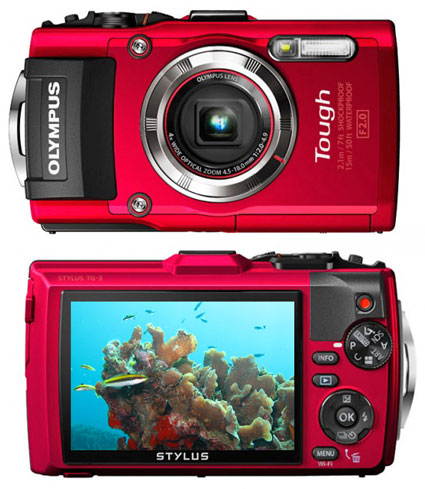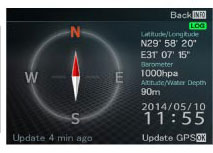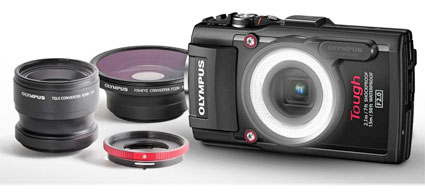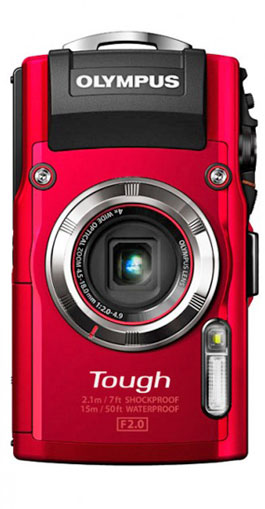|
Olympus Tough TG-3
The latest from the company that pioneered outdoor cameras. How far have they come, and are they on the right track?
(by Conrad H. Blickenstorfer and Carol Cotton)
With smartphones digging deeper and deeper into the digital imaging market, rugged outdoors cameras are one of the few bright spots for traditional camera manufacturer. But even they are on the defensive, what with all those new underwater cases for smartphones, and customers demand ever more sophisticated features. That's why Olympus is expanding outdoor shooting and sharing capabilities in even the most challenging of conditions with a new flagship. The STYLUS TOUGH TG-3, introduced March 30, 2014, brings a high-speed f2.0 lens, expanded macro capabilities, GPS, and Wi-Fi for sharing pics and full 1080p video from (almost) anywhere.

It seems like only yesterday that we wrote a detailed review of the Olympus Stylus 770 SW. But, in fact, it was over seven years ago, in February of 2007 (see here). At that point, digital cameras were on a roll. They had long since relegated old-style film cameras to the dust bin of history (digital passed film cameras sales in 2003), and they seemed unstoppable. The iPhone was still in the future, but not by much. Steve Jobs introduced it that same year, in June of 2007. Who'd have thought that just seven years later, you could get a (Nokia) cellphone with a 41-megapixel camera built in, and phones replacing cameras? Probably no one.
As far as that 2007-vintage Stylus 770 SW camera was concerned, we absolutely loved it. It set the standard for all those shockproof, waterproof, freezeproof and crushproof cameras to come. Olympus was first with a truly useful design, and jaws dropped whenever we casually dunked it into the water without a protective case. The 770 SW was the first with a depth rating of 33 feet, which meant you could take it on real dives. The 770 was such a natural underwater that we ignored the depth limit in a freshwater sink in Florida, and took it all the way down to 67 feet. It easily passed the test.
I bring all of this up to emphasize just how good this original super-tough Olympus camera was. The Olympus 1030 SW eventually surpassed it in performance, albeit not in its depth rating. But there were some problems. Though even that initial 770 was plenty tough, it scratched easily. It was very basic, with not many tricks and features. And finding one of those old xD-Picture cards (remember them?) was a pain. And finally, as impressive as 33 feet is, it's really still not enough for most scuba dives. I was painfully reminded of that when the 770 eventually did meet its maker, In Lake Tahoe, at 93 feet. I had simply forgotten that I had the camera with me when we decided to go deep.
Fast-forward to 2014. This latest, newest Olympus Tough TG-3 camera offers more than twice the resolution of the old 770—16 megapixel versus just 7.1—and it can shoot glorious 1080p video and not just tiny 640 x 480 clips like the 770 did. Its LCD is bigger and sharper, and it has many more functions and features. The TG-3 includes WiFi and GPS, and most importantly for divers, it now has a 50-feet depth rating. That means it can come along on many more dives.
Is the higher depth rating important? For divers it definitely is. Looking at my dive log, only 15% of all my dives maxed out at 30 feet, but almost half were less than 60 feet. What that means is that the TG-3 would have been able to accompany me on three times as many dives as an older 33-foot camera. That's easily the difference between a waterproof camera that's truly useful, and one that only occasionally can come along.
You could argue, of course, that even 50 feet isn't enough for the majority of dives, and that most serious divers will use a camera in a divehousing anyway. True, but divehousings are bulky and add quite a bit of cost. To be able to dive with a little 8-ounce camera that doesn't need a housing is wonderfully liberating.
But there's more, and I am framing this in the sense of how very far we've come with cameras like the Olympus Tough TG-3, and less about how it compares to its current competition. During the early years of digital cameras, there was this quest for ever higher resolution, quickly obsoleting everything that didn't measure up. That era is gone, and as long as it's enough, the number of megapixel has become almost irrelevant. What matters more is that most digital cameras, including the TG-3, have switched from CCDs (charge coupled devices) to CMOS (complementary metal oxide semiconductor) imagers. I won't go into the technical details other than to say that CMOS is more flexible in making possible onboard video, imaging tricks, buffering and, one might say, treat the imager as sort of a scratch pad where different things can be done in different places rather than using the entire imager area for just images and nothing else.
As a result, the TG-3 can not only take 16-megapixel stills, but also record full 1080p high definition video, and it can do tricks like time-lapse 720p, high-speed 120 frames per second at VGA resolution for slow motion playback, and all sorts of interval shooting.
Optics are improved as well. The old 770's f3.5 lens was very good, but the new TG-3's f2.0 lens is much brighter, and that means the camera can crank up the shutter speed for blur-free action shots. And as every underwater photographer knows, faster is better when your world, and everything in it, is in constant motion.
Good, bright glass also lets you get closer. That's important underwater where floating particulates mandate getting as close as you can. With the TG-3, Olympus took it to the next step by offering FOUR macro modes. There's "microscope," "microscope control" with a stunning maximum 44.5x magnification from less than half an inch, as well as focus bracketing and focus stacking. With the latter, multiple images are taken from foreground to background, and the areas in focus are automatically merged into one shot. And there's the optional LED Light Guide for a complete portable (above-water) macro set-up.
WiFi in cameras isn't new. I recall reviewing a WiFi camera over a decade ago. But truly useful WiFi in cameras remained elusive for a long time. The current trend is not so much making connecting them to a network, but having them communicate with smartphones. For that, Olympus offers the free Image Share app (iOS and Android) that lets you share files between the camera and the phone, and also lets you remote-control the camera with the phone. That can be fun, though for me, what I'd be looking for is quick wireless transfer between camera and computer so that I won't have to use cables or constantly take the memory card out.
GPS, likewise, has been available in cameras for quite some time, but it really hasn't been all that exciting.  For that you'd need a much larger screen than a camera has. Geotagging, though, can be quite useful, as that allows you to see exactly where each picture was taken. The included Olympus Viewer 3 software (see here) supports that functionality. The TG-3 also has an eCompass that provides quite a bit of information, including time, GPS coordinates, and altitude or depth. Keep in mind, of course, that GPS does not work underwater. For that you'd need a much larger screen than a camera has. Geotagging, though, can be quite useful, as that allows you to see exactly where each picture was taken. The included Olympus Viewer 3 software (see here) supports that functionality. The TG-3 also has an eCompass that provides quite a bit of information, including time, GPS coordinates, and altitude or depth. Keep in mind, of course, that GPS does not work underwater.
Olympus offers more accessories for the TG-3 than are available from other manufacturers for their outdoor cameras. Waterproof lens options include a fisheye converter for wide-angle shots (even underwater) and a tele converter that increases zoom capability from 4x to nearly 7x. Also shown in the picture below is the new LED ring light for macro photography.

But now a word about some inherent issues all outdoor cameras face, and especially those that can be used for diving:
- Underwater, pressure is the enemy. It's not just a matter of making the camera waterproof, it's a matter of making controls that go hard enough so the water pressure won't push them in (which I have very frequently encountered with caseless underwater cameras), but not so hard that they become nearly inoperable.
- The display is another problem. The water presses against the protective clear cover of the LCD, often so hard that you can actually see it.
- And optics underwater are such that many LCDs become virtually unreadable. Even the wonderful old 770 1030 SW models suffered from some of those issues, and it'd be great to see if Olympus has fixed it with the TG-3.
- Control buttons on outdoor cameras are another sore issue. Since consumers want tiny cameras with giant displays, there isn't much space left over for controls. And tiny controls with tiny labels are not optimal underwater where it's hard to see and you sometimes were thick gloves.
Only actual underwater testing can reveal if the TG-3 buttons work properly under pressure, if the screen is easily viewable, and how well the controls work.
Finally a universal pet peeve of mine: why on earth is it that every cellphone has at least 8GB of internal storage while cameras, including this new Olympus, have the same old 30MB they had 15 years ago?? That's almost 300 times less than even a low-end phone. It's so frustrating to run out of card storage, or forgetting to insert a card, and then have virtually no internal memory as a backup.
Bottom line
With the 16-megapixel Tough TG-3, Olympus—the pioneer in the field of rugged, waterproof outdoor cameras—continues its impressive and increasingly powerful line of compact rugged cameras. The new TG-3 appears to have what it takes to compete with the outdoor camera competition from Canon, Panasonic, Pentax, Nikon, Sony and a number of specialty manufacturers. That's not easy as ruggedness, just like technology, is a moving target. A 50-foot depth rating is no longer unique; Canon's recently released D30 can handle 80 feet.
Having spent hundreds of hours underwater with outdoor cameras (including numerous Olympus cameras), we'd love to give our readers a hands-on assessment of the Tough TG-3. Unfortunately, we're not sure if this will ever happen. The last time we asked Olympus for a Tough camera loaner for review, we were turned down cold. Unceremoniously.
We like:
- Waterproof to 50 feet.
- Freezeproof, and shockproof to 7 feet.
- Fast, bright f2.0 lens that starts wide (at 25mm equiv.)
- 1080p HD video, time lapse and high-speed tricks
- Handy, and attractive styling
- Very entertaining microscope modes
- WiFi and GPS
- Three underwater modes and underwater white balance
Not so much:
- Toughness specs no longer leading
- Only 4X zoom
- Only 32MB of internal storage!
- Tiny controls
Below is Olympus' promotional video for the Tough TG-3.
|
|
|
 Specs Olympus Tough TG-3 Specs Olympus Tough TG-3
|
|
Status
|
Added 04/2014
|
|
Camera Type
|
Waterproof Compact
|
Body
|
Unknown
|
|
Water/dust protection
|
Waterproof to 50 feet (15 meters), fully dustproof
|
|
Operating temperature
|
Down to 14°F (-10°C)
|
|
Shock protection
|
Up to 7 feet (2.1 meters)
|
Size
|
4.4 x 2.6 x 1.2 inches (112 x 66 x 31 mm)
|
Weight (oz.)
|
8.7 ounces (247 grams) incl. battery and memory card
|
Effective Pixels
|
16 megapixel |
Imager Type
|
1/2.3-inch BSI CMOS
|
Max pixel size
|
TBA
|
File formats
|
Still: JPEG;
Movie: MOV/H.264, AVI/Motion JPEG ;
Sound: Linear PCM
|
Compression
|
Unknown
|
Video modes
|
1080p, 720p, VGA, Time-Lapse 720p, High-Speed 120fps (640x480), High-Speed 240fps (432x324)
|
Audio recording
|
Linear PCM
|
Self timer
|
2/12 seconds or custom (1-30 sec start timer, 1-10 pics, 1-3 sec interval)
|
Interval shooting
|
1 sec - 24 hrs, max 99 frames, 1 sec - 24 hrs start timer
|
Image stabilization
|
Sensor-shift
|
Focal length
|
4.5 to 18mm (25-100mm)
|
Zoom (optical/digital)
|
4X/4X
|
Aperture
|
Wide: f2.0, f2.8, f8.0; tele: f4.9, f6.3, f18.0
|
Focus modes
|
Single and continuous AF (SR AUTO)
|
Min. focus macro/normal
|
0.4 inches, 3.9 inches
|
Shutter speed
|
1/2 to 1/2000 seconds
Night Scene up to 4 seconds
|
Sensitivity (ISO)
|
auto/ISO 100, 200, 400, 800, 1600, 3200, 6400, auto, high
|
Focus modes
|
Face detection AF, tracking AF, lock AF
|
Metering
|
Unknown
|
White-balance modes
|
Auto, One-touch, Cloudy, Sunny, Incandescent, Fluorescent, Underwater
|
Shooting modes
|
Mode Dial: Intelligent Auto (iAUTO), Program Auto (P), Aperture Priority (A), Microscope, Scene Modes (22), Art Filters (11), Photo Story, Custom (C)
Microscope Modes: 1. Microscope, 2. Focus Stacking, 3. Focus Bracketing, 4. Microscope Control
Scene Modes: Portrait, ePortrait, Landscape, Interval, Starlight, Night Scene, Night Portrait, Sport, Indoor, Self Portrait, Sunset, Fireworks, Cuisine, Documents, Beach & Snow, Under Water Snapshot, Under Water Wide 1 and 2, Under Water Macro, Snow, Panorama, Backlight HDR
|
Exposure compensation
|
+/-2EV in 1/3 steps
|
WiFi
|
Yes (free Olympus Image Share app iOS/Android)
|
GPS
|
Yes (geotag, landmarks)
|
eCompass
|
Yes (Latitude, longitude, air/water pressure, depth, altitude, date and time)
|
Viewfinder Type
|
none
|
LCD size
|
3.0" LCD (460k dots) TFT color, 3/2 aspect ratio
|
LCD construction
|
fixed
|
Flash type
|
built-in
|
Flash range
|
Unknown
|
Flash modes
|
Auto, Red Eye Reduction, Fill-in, Off, LED
|
Camera internal memory
|
32MB
|
Storage Medium
|
SD/SDHC/SDXC card
|
I/O
|
Multi-terminal (USB, DC power, AV), HDMI Type D
|
Battery type
|
3.6V, 1,350mAh Li-Ion LI-92B
|
CIPA Battery life
|
380 shots; 120 minutes continuous video shooting
|
List Price (as of 04/2014)
|
US$349.99
|
Web page
|
Olympus Tough TG-3
|
|
|
|
 Olympus Tough TG-3 Olympus Tough TG-3
|

|
|










